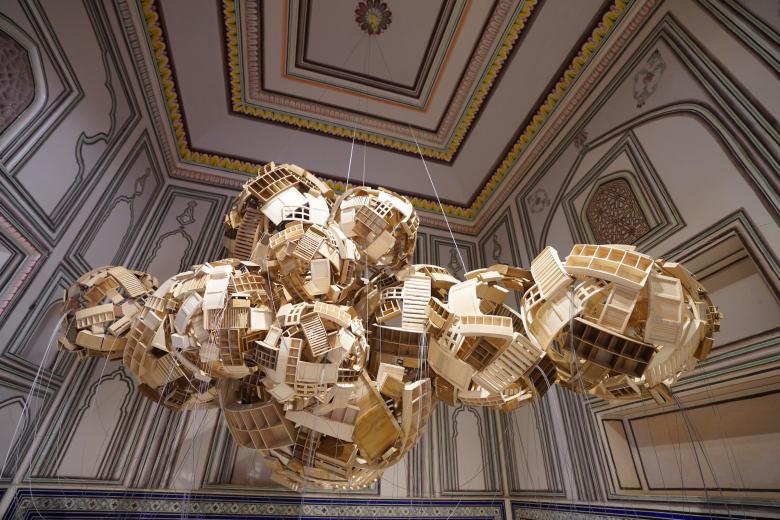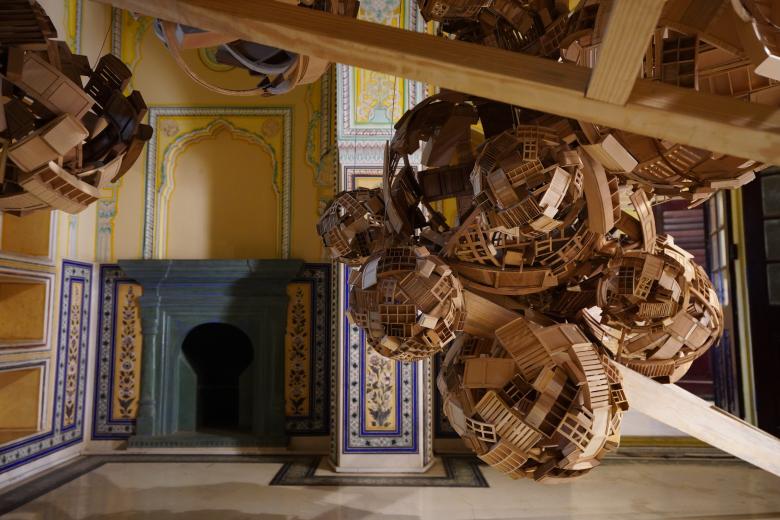Martand Khosla's 'Molecular' Constructions
Photo: Anubhav Syal, courtesy of Saat Saath Arts Foundation
The third edition of The Sculpture Park at Madhavendra Palace, Nahargarh Fort in Jaipur, India, is on display within the courtyard and apartments of the 19th-century palace until December 1, 2023. Among the fourteen contributors is New Delhi architect Martand Khosla, whose Cloud and Cloud Burst are bold counterpoints to the period rooms they are suspended within.
Created by Maharaja Sawai Madho Singh, the founder of Jaipur, in the late 1800s, Madhavendra Palace was turned into a setting for contemporary art in 2017 by curator Peter Nagy. Beforehand, the curator ran the gallery Nature Morte in New York's Lower East Side in the 1980s then revived it in New Delhi in 1997. The opening of The Sculpture Park at Madhavendra Palace twenty years later gave artists ornate indoor and outdoor spaces to respond to through their commissions. Khosla's sculptures do that through their forms, materials and the articulation of domestic elements (doors, windows, casework, etc.) in curved wood. Photos of Khosla's installations follow, with additional information provided in the captions.


Khosla's contribution is comprised of two pieces: Cloud is a series of sculptures in multiple rooms, each one featuring cloud-like, molecular forms made from teak and pine wood, and suspended from the ceiling by metal cables. (Photo: Anubhav Syal, courtesy of Saat Saath Arts Foundation)
The second piece, Cloud Burst, is more aggressive, with ladder-like pieces of lumber appearing to burst forth from the molecular forms. (Photo: Anubhav Syal, courtesy of Saat Saath Arts Foundation)
In an email correspondence, Khosla explained that his art practice is concerned with urbanization, with “how our cities emerge, collapse, expand and re-emerge.” (Photo: Anubhav Syal, courtesy of Saat Saath Arts Foundation)
The sculptures, in turn, express the “inherent violence and destruction, but also emergence and regeneration” that accompanies urbanization in India. (Photo: Anubhav Syal, courtesy of Saat Saath Arts Foundation)
Just as urban conditions breed tension — “between the ordered and the chaotic, between wealth and inequity, and between the home and the city,” to Khosla — the suspended sculptures have a disjointed relationship with the 19th-century rooms. (Photo: Anubhav Syal, courtesy of Saat Saath Arts Foundation)
The idea behind the sculptures dictated that they “float” in space, but the historical rooms provide very few points of support, just curtain and fan hooks. (Photo: Anubhav Syal, courtesy of Saat Saath Arts Foundation)
So the metal cables are arranged in “a structural web,” per Khosla, “on top of which the spheres are placed and fastened.” (Photo: Anubhav Syal, courtesy of Saat Saath Arts Foundation)
What about the wood? The sculptures are made from Indian teak and pine, common woods for architectural models in India. (Photo: Anubhav Syal, courtesy of Saat Saath Arts Foundation)
Khosla has explored the twisting and bending of domestic objects in much of his artwork (see also:
On the Brink), so, working with a team of architectural model makers, he has developed a miniature lamination method deployed for
Cloud and
Cloud Burst. (Photo: Anubhav Syal, courtesy of Saat Saath Arts Foundation)
Up close, the spherical, molecular forms of the sculptures are clearly comprised of miniature objects, such as doors, windows, ladders, bookcases and the like. (Photo: Anubhav Syal, courtesy of Saat Saath Arts Foundation)
Just as the sculptures don't touch the walls of the rooms, the individual elements of Cloud and Could Burst have gaps, holes and overlaps, leading to some appealing shadow play — another way the artworks interact with the historical rooms. (Photo: Anubhav Syal, courtesy of Saat Saath Arts Foundation)











